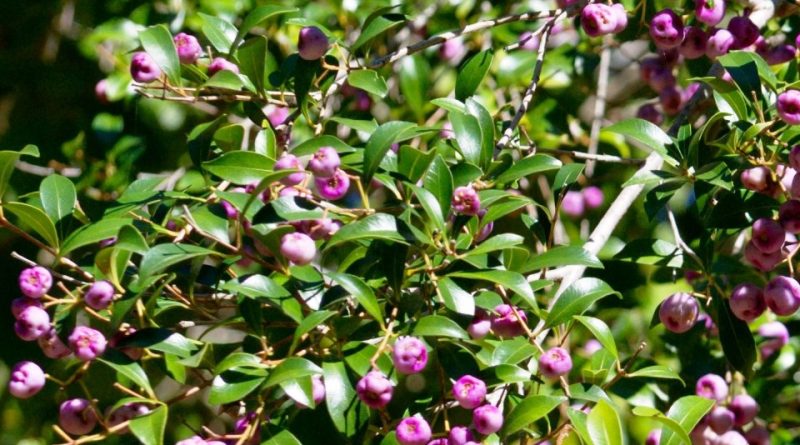Syzygium oleosum
Syzygium oleosum
The blue cherry (Syzygium oleosum (F.Muell.) B.Hyland) is an arboreal species belonging to the Myrtaceae family.
Systematics –
From a systematic point of view it belongs to:
Eukaryota domain,
Kingdom Plantae,
Subkingdom Tracheobionta,
Spermatophyta superdivision,
Magnoliophyta division,
Class Magnoliopsida,
Subclass Rosidae,
Order Myrtales,
Myrtaceae family,
Subfamily Myrtoideae,
Tribe Syzygieae,
Genus Syzygium,
Species S. oleosum.
The term is basionym:
– Eugenia oleosa F.Muell..
The terms are synonymous:
– Eugenia coolminiana C.Moore;
– Eugenia cyanocarpa (F.Muell.) Maiden & Betche;
– Eugenia oleosa var. cyanocarpa F.Muell.;
– Syzygium coolminianum (C.Moore) L.A.S.Johnson.
Etymology –
The term Syzygium comes from the Greek σύζῠγος sýzygos coupled, united, paired: in reference to the coupled leaves or united petals in some species.
The specific epithet oleosum is derived from the Latin and means oily, in reference to the numerous oil glands present in the leaves.
Geographic Distribution and Habitat –
Syzygium oleosum is a plant native to the rainforests of eastern Australia and moist sclerophyllous forests, where it is found in a wide range in the east, from Cooktown, in northern Queensland, to Illawarra, in New South Wales.
Its habitat is that of coastal, subtropical and warm temperate rainforests, often near waterways.
Description –
Syzygium oleosum is a small tree, which can grow 4 to 15 m tall.
The bark is wrinkled, reddish brown in color and the foliage is pyramidal in shape, thick up to the base.
The leaves are opposite, on a 2-10 mm long petiole, 3-12 cm long and 1-4 cm broad, simple and lanceolate to ovate in shape, with the upper surface glossy dark and the lower one paler; the young shoots are bronze in colour. On the leaves there are oily parts that are decidedly aromatic when crushed, with an aroma reminiscent of lemon.
The flowers are small and creamy-white in colour; they are grouped in inflorescences in axillary cymes concentrated in the terminal part of the branches. The flowers have 4 ovate, concave, 2,5-3,5 mm long petals, with numerous punctiform oil glands, and 5-16 mm long stamens.
The fruits are globular in shape, 1-2.5 (4.0) cm in diameter, of a glossy pink to bluish-purple color when ripe, with a cavity within which is contained a single seed of 0, 5-1cm in diameter.
Cultivation –
Syzygium oleosum is a plant that grows in tropical and subtropical rainforests and moist sclerophyllous forests of eastern Australia.
It is a fast-growing plant with thick and elegant foliage, to which is added the long-lasting flowering; for this reason it is often used as border barriers, even windbreaks; moreover, for some years it has been marketed in pot as a plant for interior decoration, where it proves to be particularly resistant.
The fruit is edible and is sometimes harvested from the wild for local use.
This plant can tolerate some frost, but needs protection from prolonged or severe frosts. In fact, it is a species suitable for zones with a tropical, subtropical and marginally warm temperate climate, where it can resist temperatures up to about -3 °C; adult plants can resist, with damage to the foliage, a few degrees less.
For its cultivation it needs a position from full sun to partial shade. It grows best in reasonably well-drained soil and especially fertile soil.
It is drought tolerant, but grows best when there is no water shortage; among other things, the plants tend to grow rather quickly if there is adequate humidity.
Flowering and fruiting do not occur every year, but in some years it is prolific.
This plant usually reproduces by seed, in a sandy and organic substratum, which germinates in 2-6 weeks at the temperature of 22-24 °C, or by cutting.
Customs and Traditions –
Syzygium oleosum is a plant native to eastern Australia and whose genetic studies have revealed it rather close to the genus Eugenia which is instead widespread in the Americas. Some botanists believe that the genus Syzygium should be incorporated into the genus Eugenia.
However this plant is known by various common names; among these are: blue cherry, blue lilly pilly, coastal-cherry, oily satinash, scentend satinash, scrub cherry (English); cerezo azul (Spanish).
The fruit can be eaten fresh from the tree or cooked. It has a pleasantly crunchy texture and is slightly aromatic and sweet. Jams, jellies and wine can also be made from the fruit.
As mentioned, it is also used as an ornamental plant.
No medicinal uses are known.
Among other uses, remember that wood is rarely large enough to be used usefully.
Method of Preparation –
Syzygium oleosum is a plant whose fruits can be eaten fresh or cooked. They have a pleasant fresh texture and are delicately aromatic and sweet.
The fruits can be made into jams, jellies and alcoholic beverages.
They have a pleasant taste, even if quite variable from area to area.
The flavor is crisp and watery with hints of lavender and ginger. It is usually quite palatable, or even delicious, although it can sometimes be resinous as well.
Guido Bissanti
Sources
– Acta Plantarum – Flora of the Italian Regions.
– Wikipedia, the free encyclopedia.
– GBIF, the Global Biodiversity Information Facility.
– Useful Tropical Plants Database.
– Conti F., Abbate G., Alessandrini A., Blasi C. (ed.), 2005. An annotated checklist of the Italian vascular flora, Palombi Editore.
– Pignatti S., 1982. Flora of Italy, Edagricole, Bologna.
– Treben M., 2000. Health from the Lord’s Pharmacy, Advice and experiences with medicinal herbs, Ennsthaler Editore.
Photo source:
– https://medialib.naturalis.nl/file/id/L.2531296/format/large
Attention: The pharmaceutical applications and alimurgical uses are indicated for informational purposes only, they do not in any way represent a medical prescription; we therefore decline all responsibility for their use for curative, aesthetic or food purposes.


